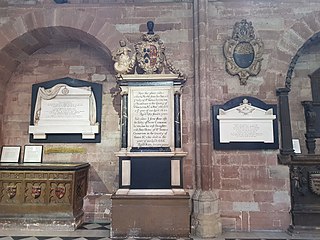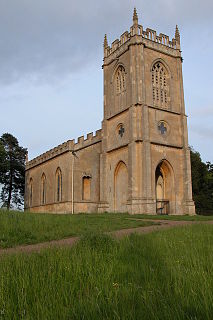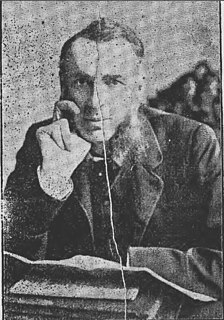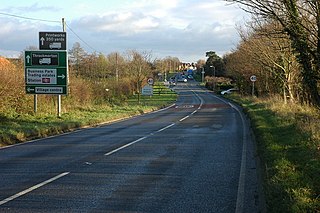Related Research Articles

John Somerset Pakington, 1st Baron Hampton,, known as Sir John Pakington, Bt, from 1846 to 1874, was a British Conservative politician.

Sir Thomas Lyttelton, 1st Baronet was an English Royalist officer and politician from the Lyttelton family during the English Civil War.

White Ladies Aston is a village in the Wychavon local government district of Worcestershire, England, United Kingdom, and also lends its name to the Civil Parish in which the village is located. The village is located to the east of the A44 which started as a Saltway linking Droitwich to Oxford. To the south is Pershore and five miles west is Worcester. The parish is bound to the east by the Bow Brook. The parish, according to the 2011 census, has 87 households with 220 residents.

John Walpole Willis was a British judge of Upper Canada, British Guiana, the Supreme Court of New South Wales, and resident judge at Port Phillip, Melbourne.
Peregrine Hoby, was an English landowner and member of parliament who sat in the House of Commons at various times between 1640 and 1679.

Sir Walter Devereux, 5th Viscount Hereford, 2nd Baronet of Castle Bromwich, was an English politician who sat in the House of Commons at various times, between 1614 and 1624, before succeeding to the family Viscountcy in the peerage of England.

Croome D'Abitot is a village and civil parish, which shares a joint parish council with Severn Stoke, in the Malvern Hills District in the county of Worcestershire, England. The parish church of St Mary Magdalene is situated in the grounds of Croome Court.

John William Bund Willis-Bund was a British lawyer, legal writer and professor of constitutional law and history at King's College London, historian who wrote on the Welsh church and other subjects, and local Worcestershire politician.
There have been two baronetcies granted to the Willises of Fen Ditton, both in the Baronetage of England. The Willis Baronetcy, of Fen Ditton in Cambridgeshire, was first created in the Baronetage of England on 15 December 1641 for Thomas Willis, son and heir of Inner Temple barrister and landowner Richard Willys, of Fen Ditton and Horningsey, Cambridgeshire, by Jane, daughter and heir of William Henmarsh, of Ball's Park, in Ware, Hertfordshire. Richard's brother, Thomas, was Clerk of the Crown in Chancery.
Sir William Russell, 1st Baronet, of Wytley, was an English politician who sat in the House of Commons in 1625. He was an officer in the Royalist army during the English Civil War and, as Governor of Worcester, he refused entry to the Parliamentary cavalry shortly before the Battle of Powick Bridge — the first cavalry skirmish of the Civil War.

Grafton Manor was established before the Norman Conquest. Grafton means "settlement at or near the wood" and may indicate a role in woodland management within a larger estate, for instance.

Sir Henry Bromley was an English landowner and politician who sat in the House of Commons at various times between 1584 and 1604. He was twice imprisoned for his political activities, the second and most serious occasion in the aftermath of the Essex Rebellion. Restored to favour in the Jacobean period, he was vigorous in suppressing the Gunpowder Plot.

Sir Humphrey Coningsby,, was an English lawyer, a senior judge as a Justice of the King's Bench and a major landholder.

William Neville of Penwyn and Wyke Sapie, Worcestershire, was the son of Richard Neville, 2nd Baron Latimer, and the author of The Castell of Pleasure. In 1532 he was accused of treason and dabbling in magic.
John Ffolliott was an Irish landowner and Member of Parliament.
Colonel Sir Gilbert Gerard was a Royalist officer during the English Civil War.

Arthur Clutton-Brock was an English essayist, critic and journalist.
General Frederick Rennell Thackeray was a senior British Army officer.
William Sandys, 6th Baron Sandys, was a Cavalier officer in the Royalist army during the English Civil War.
Thomas Geers Winford (c.1697–1753), of Bridge Sollers, near Hereford, and Glasshampton, Worcestershire. was a British lawyer and Tory politician who sat in the House of Commons between 1727 and 1748.
References
- 1 2 3 4 5 6 Burke's Landed Gentry 14th ed. (reprint of 1921 ed.), ed. A. Winton Thorpe, 1925, p. 238, 'Willis-Bund of Wick Episcopi' pedigree
- ↑ "Parishes: St John in Bedwardine - British History Online". British-history.ac.uk. Retrieved 22 January 2019.
- ↑ Bishop and Chapter in Twelfth-Century England: A Study of the 'Mensa Episcopalis', Everett U. Crosby, Cambridge University Press, 1994, p. 248
- 1 2 "Parishes: St John in Bedwardine - British History Online". British-history.ac.uk. Retrieved 22 January 2019.
- ↑ "Parishes: White Ladies Aston - British History Online". British-history.ac.uk. Retrieved 22 January 2019.
- ↑ "Parishes: Fladbury - British History Online". British-history.ac.uk. Retrieved 22 January 2019.
- ↑ Miscellany, vol. 2, Worcestershire Historical Society, 1967, p. 165
- ↑ "Catalogue description : 14 deeds re Offenham (Willis & Bund families), Wick Episcopi, Powick, St. John's,..." Retrieved 22 January 2019– via National Archive of the UK.
- ↑ The Heraldry of Worcestershire, vol. 1, H. Sydney Grazebrook, J. Russell Smith, 1873, pp. 91-92, 318
- ↑ Vicissitudes of Families, vol. II, ed. Sir Bernard Burke, 1869, p. 16
- ↑ The Heraldry of Worcestershire, vol. 2, H. Sydney Grazebrook, J. Russell Smith, 1873, p. 629
- ↑ The Oxford Church Movement: Sketches and Recollections, G. Wakeling, S. Sonnenschein, 1895, p. 212
- ↑ E.P. Thompson and the Making of the New Left: Essays and Polemics, ed. Cal Winslow, Monthly Review Press (New York), 2014, p. 309
- ↑ E. P. Thompson, Objections and Opinions, Brian D. Palmer, Verso (London, New York), 1994, pp. 1, 186
- ↑ Burke's Peerage, Baronetage and Knightage 2003, vol. 3, p. 3866
- ↑ A Genealogical and Heraldic History of the Landed Gentry of Great Britain and Ireland, 1871, vol II, ed. Sir Bernard Burke, pg 1526–1527
- ↑ Burke's Landed Gentry, 18th ed., vol. III, ed. Hugh Montgomery-Massingberd, 1972, 'Milward formerly of Redditch' pedigree
- ↑ Chatwin, Bruce (1977), In Patagonia, London: Jonathan Cape, pp. 1–3
- ↑ Burke's Irish Family Records 1976, p. 298
- ↑ Burke's Peerage, Baronetage and Knightage 2003, vol. 2, p. 1702
- ↑ Burke's Peerage, Baronetage and Knightage 2003, vol. 1, p. 953, vol. 3, p. 3866
- ↑ The Heraldry of Worcestershire, Being a Roll of the Arms Borne by the Several Noble, Knightly, and Gentle Families, which Have Had Property Or Residence in that County, from the Earliest Period to the Present Time; with Genealogical Notes, Collected from the Heralds' Visitations, Ancient Manuscripts, Heraldic Dictionaries, Church Monuments, Personal Seals, and Other Trustworthy Sources, vol. I A-L, H. Sydney Grazebrook, John Russell Smith (36 Soho Square), 1873, pp. 91-2